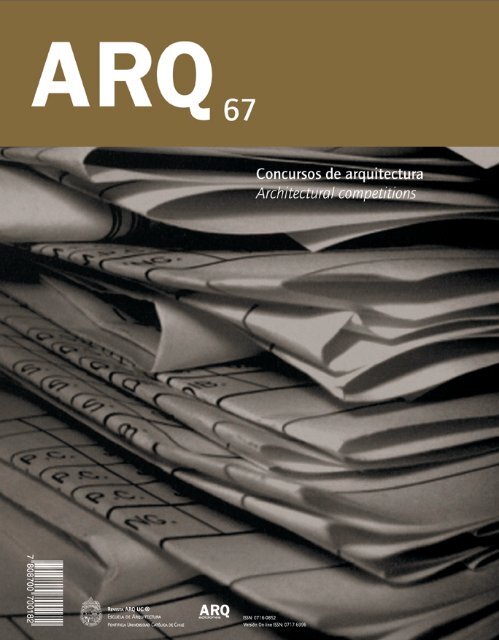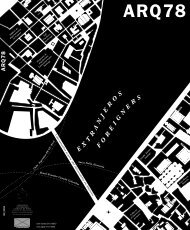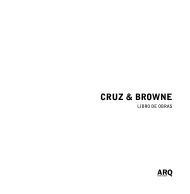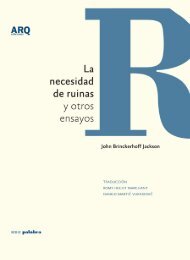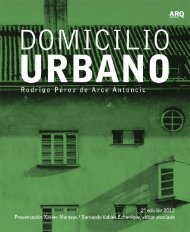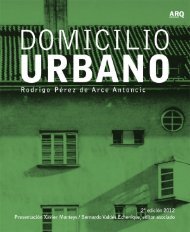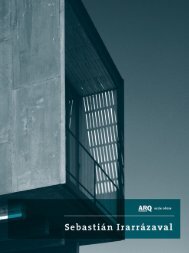Descargar PDF - Ediciones ARQ
Descargar PDF - Ediciones ARQ
Descargar PDF - Ediciones ARQ
- No tags were found...
You also want an ePaper? Increase the reach of your titles
YUMPU automatically turns print PDFs into web optimized ePapers that Google loves.
64 67Lecturas ReadingsLa arquitectura como argumentoD O G M A/OFFICE, concurso para una nueva Ciudad administrativa en CoreaArchitecture as argumentD O G M A/OFFICE, an architectural competition for a new administrative City in KoreaJorge Heitmann Arquitecto, Pontifi cia Universidad Católica de ChileJorge Heitmann Architect, Pontifi cia Universidad Católica de ChileEn el marco de una utopía, el concurso de arquitectura alcanza especial relevancia. El autorexamina el concurso para la nueva Ciudad administrativa en Corea; desde el análisis delencargo a la propuesta de Una gramática para la ciudadde DOGMA/OFFICE, portadorade un lenguaje rotundo que posiciona a la ciudad en el centro del debate.In a utopian framework, architectural competitions assume special importance. Theauthor examines the competition for Korea’s new administrative city, from an analysis ofthe challenge set to DOGMA/OFFICE’s proposed Grammar for the city, whose ambitiouslanguage made the city a focus of debate.PR O B L E M A/ ¿Dónde ponemos el acento si el encargo es una ciudad entera,de pies a cabeza y desde cero? Esta pregunta directa cuya respuesta selimitó por siglos a breves instrucciones en tratados como nuestras familiaresLeyes de Indias hoy es, aparentemente, inabarcable.La situación reinante actual, de un universalmente aceptado capitalismo,que gradualmente ha ido transfiriendo el poder desde el ámbitopolítico hacia uno meramente económico, nos ha llevado a identificarnuestras aspiraciones de libertad y ansias democráticas con las políticasde libre mercado, como única alternativa practicable.En este curso la arquitectura ha abandonado, parafraseando a KerstenGeers, la posibilidad de ser proyecto, de ser un verdadero argumento yno una mera solución 1 .En un contexto bombardeado por posts (histórico, crítico, teórico,moderno, postmoderno, etc.) hemos optado por lo que aparentementees la única vía de escape, un pragmatismo acomodativo, relegando partede lo que históricamente ha caracterizado a nuestra disciplina: su capacidadde resistencia como alternativa a lo real y catalizador de posiblesnuevas realidades.Este enfoque realista asumido por la arquitectura ha resultado en proyectosque, por un lado, sólo se centran en aspectos sensuales, en lacapacidad icónica o bien en un argumento, que con vanas aspiracionescientíficas, pretende derivar de estudios, estadísticas, sistemas y diagramasuna cierta forma arquitectónica que, finalmente, resulta foránea yno termina de convencer. A pesar de que en casos particulares puedenllegar a responder a una determinada situación con relativo éxito, sevuelven más y más inverosímiles cuando el problema se torna tan complejo(como el diseño de una ciudad) que cualquier intento por reducirloa datos ciertos, aparece irrelevante e inadecuado.Es en este punto donde la arquitectura tiene dos posibles salidas: oreinventa su actitud para tener algo que decir al respecto o desaparece,por lo menos de estas ligas, y se limita a resolver problemas acotadoscon soluciones más o menos geniales o tristes en mayor o menor grado.Recientemente, sin embargo, una mayor toma de conciencia sobre laimperfección de un sistema de mercado que lejos de ser libre ha producidouna concentración monopólica del poder económico, y ha acarreadodesigualdades aberrantes, parece abrir nuevas posibilidades.En la arquitectura, infortunados ejemplos como el concurso parala Zona Cero en Manhattan después de los atentados del 11 de septiembre,en que las disputas de autoridad por parte de los diversosorganismos interesados terminaron finalmente por convertir el proyectode un memorial para las víctimas del terrible evento en unaempresa más de la especulación inmobiliaria, es otro factor que hapuesto en evidencia esta crisis.Como resultado, una nueva actitud parece estar incubándose en laPRO B L E M/ Where do we place the emphasis if the project is a whole city, fromhead to toes and starting from scratch? The answer to this question, whichwas limited for centuries to brief instructions in treaties such as our familiarLeyes de Indias, is apparently unapproachable today.The current universally accepted status of capitalism, which has graduallybeen transferring its power from the political to a merely economic one, hasled us to identify our desire for freedom and democracy with that of freemarket policies as the only practical option.Along these lines, architecture has abandoned, citing Kersten Geers,the possibility of being a project, of being a real argument and not amere solution 1 .In a context bombarded by posts(historical, critical, modern, postmodern,etc.), we have opted for what is apparently the only escape route, an accommo-dativepragmatism, putting aside part of what has historically characterizedarchitecture: its resistance as an option to what is real and as a catalyst ofpossible new realities.This realisticapproach adopted by architecture has resulted in projects that,on one hand, only focus on the sensual aspects, the iconic capacity or elsein an argument that, with futile scientific expectations pretends to derivea certain architectural form from studies, statistics, systems and diagramsthat, finally, end up being foreign and unconvincing. In spite of special caseswhere they may respond to a specific situation with relative success, theybecome more and more implausible when the problem becomes very complex(such as in designing a city), so that any attempt to reduce it to real informationseems irrelevant and inadequate.This is the point where architecture can take either one of two directions:either it reinvents its attitude so as to have something to say aboutit or else it disappears, at least from these leagues, and limits itself toresolving problems with solutions that are more or less brilliant or sadto a greater or lesser degree.Recently, however, a higher awareness of the imperfect market system,which is far from free, has produced a concentration of economicpower and brought about aberrant inequalities, seems to be openingup new possibilities.Unfortunate examples in architecture, such as the project for GroundZero in Manhattan after 9/11, in which disputes over authority on behalf ofvarious interested organizations finally ended up turning the project intoanother real estate speculation instead of a memorial for the victims of thisterrible event, is another instance of this crisis.This has resulted in a new attitude that seems to be incubating along thelines of what George Baird and Reinhold Martin anticipated in the articlesthat appeared in the Harvard Design Magazine, numbers 21 and 22 respectively.Referring to the same case of the Ground Zero project, they concludewith a call to review this pragmatic position adopted by architecture.Palabras clave: Urbanismo–Corea, concursos, ciudades administrativas, DOGMA/OFFICE, Corea del Sur.Key words: Urbanism-Korea, competitions, administrative cities, DOGMA/OFFICE, South Korea.
Lecturas Readings 67651 Kersten Geers, conferencia enla exhibición Le Corbusier: el artede la arquitectura en el InstitutoHolandés de Arquitectura NAI, 4 dejunio de 2007.1 Kersten Geers, conference as partof the exhibition on Le Corbusier:the art of architecture, NetherlandsArchitecture Institute NAI, June4 th , 2007.01 02 0301 A 120 km de Seúl, la nueva Ciudad administrativa se emplaza en la cuenca del río Geum.02 El crecimiento es desde los bordes hacia el interior, fijando la planta cuadrada de la ciudad.03 Como si fuera una casa, la ciudad está conformada por muros y recintos.01 120 km from Seoul, the new administrative city is located in the Geum River basin.02 The growth is from the edges inward, generating the city’s square plan.03 As if it were a house, the city is composed of walls and the spaces they defi ne.línea que en cierta medida anticipaban George Baird y Reinhold Martinen los artículos aparecidos en Harvard Design Magazine, números 21 y 22respectivamente. Partiendo por el mismo caso del concurso para la ZonaCero, concluyen con un llamado a la revisión de esta postura pragmáticaadoptada por la arquitectura.“El problema de la utopía debe ser traído de vuelta al debate arquitectónico. Pero nodebe ser malinterpretado como un llamado a un mundo perfecto, un mundo aparte,una totalidad imposible que inevitablemente se disuelve en el totalitarismo. En vez,la utopía debe ser interpretada literalmente, en su origen etimológico de no–lugar,es decir en ninguna parte, no por ser ideal e inaccesible, sino porque, en una perfectasimetría espejada, es a la vez en todas partes” (Martin, 2005).Es precisamente en este contexto en el cual el concurso de arquitectura,que en la última década ha alcanzado una relevancia sin precedentes,aparece habilitando esta posibilidad crítica de la arquitectura, y esen ese contexto que se presenta el siguiente proyecto.EN C A R G O / En mayo de 2005 un comité presidencial especialmente designadoanunció la apertura del proceso para la construcción de una nuevaCiudad multifuncional administrativa en Corea del Sur. La preocupaciónpor el dispar desarrollo que ha experimentado el resto del país encomparación con el Área Metropolitana de Seúl, como resultado del aceleradocrecimiento económico del noreste asiático en las últimas décadas,finalmente motivó estrategias radicales de descentralización entrelas cuales, la reubicación de las principales instituciones político–administrativasen una nueva ciudad, se incluyen como iniciativa central.La nueva Ciudad que originalmente estaba planteada para 500.000habitantes en una superficie de 73 km 2 (algo así como la comuna de LaFlorida en la ciudad de Santiago, 1,5 veces más densa), además de alojarel cuerpo administrativo (12 ministerios se reubicarían en la nuevaCiudad), debería considerar otras actividades propias de toda ciudadmultifuncional, poniendo especial énfasis en los aspectos industriales,educacionales y culturales. La ubicación escogida fue la cuenca del río“The question of utopia must be put back on the architectural table. But it mustnot be misread as a call for a perfect world, a world apart, an impossible totalitythat inevitably fades into totalitarianism. Instead, utopia must be read literally,as the non-place written into its etymological origins that is nowhere not becauseit is ideal and inaccessible, but because, in perfect mirrored symmetry, it is alsoeverywhere” (Martin, 2005).It is precisely in this context in which the architectural competition,which in the last decade has reached unprecedented relevance, appearsto be empowering this possibility of architectural criticism and it iswithin this context that the following project is presented.PRO P O S A L / In May 2005, a specially-appointed presidential committeeannounced the opening up of the process to construct a new multi-functionaladministrative City in South Korea. Concern for the uneven developmentof the rest of the country in comparison with the MetropolitanArea of Seoul as a result of the quick economic growth experienced bynortheast Asia over the last decades, finally motivated radical decentralizationstrategies which included the relocation of the main politicaladministrativeinstitutions to a new city.The new City, which was originally proposed for 500.000 inhabitants ona surface of 73 km2 (comparable to the community of La Florida in thecity of Santiago, with 1,5 times more density), in addition to housing 12ministries, had to take into account other activities typically found in anymulti-functional city, with special emphasis on industrial, educational andcultural aspects. The location chosen was the basin of the Geum River, inthe province of Chungcheongnam, 120 km south of Seoul.The first phase of this process consisted of organizing an internationalcompetition of a wide variety of ideas, of which the winning projectwould be defined to serve as the base for the development of the MasterPlan of the new City. This architectural competition in Chile is alreadyquite familiar due to the publication of the article Ciudad Nueva in <strong>ARQ</strong> 64,
66 67Lecturas Readings2 Pier Vittorio Aureli y MartinoTattara, ambos graduados en elBerlage Institute en Rótterdam,además de obtener el primer lugaren el concurso para la nueva Ciudadadministrativa en Corea el 2005,en octubre de 2006 se les concedióel primer premio Iakov Chernikhovpara arquitectos jóvenes. Pier VittorioAureli ha estado involucrado enactividades académicas en la ArchitecturalAssociation, Berlage Institute,Columbia University y TU Delft.El 2005 presentó su tesis doctoralBerlage/TU Delft La posibilidad deuna arquitectura absoluta sobre lacual se prepara una publicación.En marzo de 2007 formó parte dela organización de la exhibiciónBrussels, a manifesto: towards thecapital of Europe y en mayo delmismo año fue uno de los curadoresde la tercera Bienal de Arquitecturade Róterdam. Actualmente ambosforman parte del cuerpo docente delBerlage Institute.3 OFFICE KGDVS (Kersten Geers,David van Severen) fundada el2002 con sede actual en Bruselas,ha obtenido primeros lugares envarios concursos de arquitectura,dentro de los cuales se cuentanel concurso Arquine para el crucefronterizo entre México y EEUU,el Centro de Arte ContemporáneoWiels en Bruselas y el concurso parala nueva Ciudad administrativa enCorea. Ambos complementan lapráctica profesional de arquitecturacon labores docentes en Ghent Universityy TU Delft. En mayo de 2007fueron invitados a formar parte de latercera Bienal de Róterdam desarrollandouna propuesta para Ceuta, elenclave español en África.Geum, en la provincia de Chungcheongnam, 120 km al sur de Seúl.La primera fase de este proceso consistiría en la organización de unconcurso internacional de ideas ampliamente abierto, en el cual se definiríaun proyecto ganador destinado a servir como base para el desarrollodel Plan Maestro de la nueva Ciudad, concurso que en Chile en parteya nos es familiar por la publicación del artículo Ciudad Nueva en <strong>ARQ</strong>64, donde se presentó la única propuesta chilena participante, elaboradaen colaboración por Cristián Undurraga y Pablo Allard, y que fueseleccionada como uno de los proyectos finalistas.A esta fase inicial seguiría la formulación de un plan de desarrollo endistintas etapas con nuevos llamados a concursos independientes paralas diferentes áreas del proyecto, cuya construcción debía iniciarse enjulio de 2007 para estar definitivamente concluida el 2030.El variopinto jurado de siete miembros, tres locales y cuatro importados,encabezado por el geógrafo David Harvey, Nader Tehrani, Winy Maasy Arata Isozaki, después de dos días de intensa deliberación decidió torcerla estructura ideada para la premiación; un primer lugar, dos segundoslugares, tres terceros y cuatro menciones, optando por una decisión máscómoda, designando cinco primeros lugares y cinco menciones.Aparentemente –siendo confirmado por concursantes y miembros deljurado– uno de los principales factores que potenciaron el debate y frustraronlos intentos por designar un único ganador, fue la incorporaciónde la propuesta designada con el código DO17888, que posteriormente,una vez seleccionada dentro de los cinco ganadores, revelaría la identidadde DOGMA/OFFICE.El proyecto en cuestión era el resultado de la colaboración de dosoficinas jóvenes con sede en Róterdam, formadas por arquitectos quebordeaban los 30 años de edad. DOGMA/OFFICE, compuesta por PierVittorio Aureli y Martino Tattara 2 y OFFICE KGDVS 3 , de Kersten Geersy David van Severen. Los nombres de ambas oficinas fueron adoptadoscon motivo de este concurso.PROY E C T O / La propuesta Una gramática para la ciudadestá basada en la reduccióndel problema a pocos factores. En primer lugar, identificando la incapacidaddel arquitecto para definir la manera en que los programas varían, losflujos se desenvuelven y el cambio que sucede, es la mutabilidad de la vidaurbana, lo que figura como la esencia de la ciudad.“Creemos que solamente enfocándose en su condición absoluta, la arquitectura puedeverdaderamente (y honestamente) evocar, por deducción negativa, la imprevisible complejidadde la vida que se desenvolverá en ella” (DOGMA/OFFICE, 2006).En segundo lugar, tomando en cuenta el carácter privado de los actualesdesarrollos urbanos a gran escala, especialmente en Asia en losúltimos años, que en la búsqueda de la rentabilidad de sus capitales,fallan en conferir valor al espacio público como espacio colectivo queda forma a la vida en la ciudad. “Democracia no es absoluta libertad sinouna serie de reglas precisas que garantizan igualdad al permitir las libertadesindividuales”(DOGMA/OFFICE, Ídem). Con estos principios en mente, loque proponen es una ciudad formada por recintos en vez de calles.Una serie de muros urbanos, edificios cruciformes de 158,4 m por lado y36 m de altura, dispuestos en una retícula de 180 m x 180 m que dejanuna separación de 21,5 m entre ellos, van definiendo una secuencia derecintos interconectados en la ciudad, cuya planta cuadrada tiene 3,6 kmde arista. La solución de sus fachadas es accesoria y su representación lade un recorte blanco sobre un fondo que es a la vez el contenido.Estos muros urbanos no completan la ciudad, forman solamente el 30%de los metros cuadrados edificados requeridos y son la infraestructuraarquitectónica básica al servicio de la generación de espacio. Los recintosresultantes no sólo acomodarían la vida urbana colectiva, sino tambiénel desarrollo consecutivo de nuevos y variados edificios. “Los murosurbanos y los recintos resultantes no son la forma conclusa de la ciudad sino másbien su comienzo definitivo” (DOGMA/OFFICE, Ídem).La opción tomada por este marco habitable como principio para laciudad tiene por objetivo asumir la coincidencia del carácter fijo y a lavez flexible de la ciudad, lo determinante del marco y lo impredeciblede su contenido se resuelven en una forma única.La ciudad, enteramente peatonal, se conecta al resto del territorio porcarreteras que llegan a su periferia donde se ubican grandes áreas deestacionamientos vinculados al sistema de transporte público subterráneoque nutre la ciudad internamente. Estos cuatro principales puntosdeterminarán el inicio de la construcción de la ciudad desde la periferiahacia su centro, preservando la claridad del límite urbano y laimagen de la ciudad.Los mismos autores reconocen lo arbitrario del principio muro–recintoadoptado, pero una vez establecido este principio, asumen el compromisocon la lógica que se deriva del mismo.El resultado es una ciudad con una imagen clara que se aleja de lamera iconografía y define el mínimo pero rotundo diseño necesariopara su posterior desarrollo.La primera fase del concurso concluyó a fines de 2005, repartiéndoselos premios en la situación previamente descrita y a pesar de lasefusivas recomendaciones por parte de algunos de los miembros deljurado, el plan maestro definido posteriormente, de manera previsible,no muestra evidencia alguna de haber considerado la propuestade DOGMA/OFFICE; más bien parece el desarrollo lógico de otra de laspropuestas ganadoras.Para la segunda etapa en la que se invitó especialmente a los ganadoresde la primera fase a desarrollar una de las zonas residenciales definidasen el Plan Maestro, DOGMA/OFFICE participó optando por no repetir
Lecturas Readings 67672 Pier Vittorio Aureli and MartinoTattara, both graduated from theBerlage Institute in Rotterdam. Inaddition to obtaining fi rst place inthe project for the new administrativeCity in Korea in 2005, was alsoawarded fi rst prize Iakov Chernikovfor young architects in October2006. Pier Vittorio Aureli has beeninvolved in academic work at theArchitectural Association, BerlageInstitute, Columbia University andTU Delft. In 2005, he presentedhis doctoral thesis at Berlage/TUDelft The possibility of an absolutearchitecture which is being preparedfor publication. In March 2007, hehelped organize the exhibition Brussels,a manifesto: towards the capitalof Europe and in May that sameyear he was one of the curators ofthe Third Architecture Biennale ofRotterdam. Currently, both form partof the teaching staff at the BerlageInstitute.3 OFFICE KGDVS (Kersten Geers,David van Severen) founded in2002 is currently headquartered inBrussels. It has obtained fi rst placein several architecture competitions,including the Arquine competitionfor the border cross between Mexicoand the USA, the Wiels Center forContemporary Art in Brussels andthe competition for the new administrativeCity in Korea. Both complementtheir architectural practicewith teaching at Ghent Universityand TU Delft. In May 2007, theywere invited to participate in theThird Architecture Biennale of Rotterdamwith a proposal for Ceuta,the Spanish enclave in Africa.where the only Chilean proposal presented, was prepared in collaborationby Cristián Undurraga and Pablo Allard, and was selected as one ofthe finalists.This initial phase continued with the formulation of a developmentplan in several stages, with new independent tenders for thevarious project areas, whose construction had to start in July 2007 tobe definitely finished by 2030.After a two-day deliberation, the diverse seven-member jury, includingthree locals and four internationals, headed by geographer DavidHarvey, Nader Tehrani, Winy Maas and Arata Isozaki, decided to givea special twist to the original awarding structure (one first place,two runners-up, three third places, and four honorable mentions)and opted for a more comfortable decision by awarding five firstplaces and five honorable mentions.Apparently -confirmed by participants and jury members alike-one of the main reasons that fostered the debate and frustrated anyattempt to designate one sole winner, was proposal DO17888, whichlater on, once chosen as one of the five winners, was revealed asDOGMA/OFFICE.The project under question was the result of the collaborationbetween two young offices located in Rotterdam, comprised of architectsin their early thirties: DOGMA/OFFICE, composed of Pier VittorioAureli and Martino Tattara 2 , and OFFICE KGDVS 3 , belongingto Kersten Geers and David van Severen. Both offices joined theirnames for the purpose of this competition.PR O J E C T / The proposal, A grammar for the city, is based on reducing theproblem to a few factors. In the first place, on identifying the incapacityof the architect to define the way in which the programs vary,the flows are smooth and easy-going and the change that occurs isthe mutability of urban life, which is the essence of the city.“We believe that if only focused on its absolute condition, architecture cantruly (and honestly) evoke, by negative deduction, the unforeseeable complexityof the life that will occur in it” (DOGMA/OFFICE, 2006).Secondly, taking into account that current large-scale urbanizationprojects are in private hands, especially in Asia over the lastfew years, that in their search for profits fail to confer value topublic space as a collective space that shapes city life. “Democracyis not absolute freedom but rather a set of precise rules that guaranteeequality by allowing individual liberties”(DOGMA/OFFICE, Idem).With these principles in mind, what they propose is a city madeup of compounds instead of streets.A series of urban walls, formed by cruciform buildings 158,4 m per eachside and 36 m tall, placed in a 180 m by 180 m grid with a 21,5 m sepa-ration between them, define a sequence of interconnected compoundswithin the city, whose square ground plan has a 3,6 km perimeter. Itsfacades are accessorial and represent a white cut on a backdrop that,at the same time, is its content.These urban walls do not complete the city but only form 30% ofthe required square-meter construction and are the basic architecturalinfrastructure that serve to generate spaces. The resulting compoundsnot only accommodate the collective urban life but also theconsecutive development of new and varied buildings. “Urban wallsand their resulting compounds are not the conclusive form of the city butrather their definite beginning” (DOGMA/OFFICE, Idem).The purpose of the option taken by this habitable framework as aprinciple for the city is to accept the fixed as well as flexible characterof the city; the determining factor of the framework and what isunpredictable of its content is resolved in only one way.The city, completely pedestrian, is connected to the rest of thecountry through highways that reach their periphery, wherelarge parking lots are located, connected to the undergroundpublic transport system that feeds the city internally. These fourmain points will define where the city’s construction will begin,from the periphery towards its center, keeping clear the urbanlimit and the city image.The same authors acknowledge the willfulness of the adopted wallcompoundprinciple but once established, they take on the compromiseto follow up on the logic of this principle.The result is a city with a clear image that takes distance from themere iconography and defines the minimum but categorical designneeded for its subsequent development.The first phase of the competition concluded at the end of 2005.The awards were distributed as described above and in spite of thestrong recommendations on behalf of some of the jury members, themaster plan defined later on, as was predicted, shows no evidenceof having taken into account the DOGMA/OFFICE proposal; on thecontrary, it resembles much more the logic development of anotherwinning proposal.In the second stage in which the winners of the first phase werespecially invited to develop one of the residential areas definedin the Master Plan, DOGMA/OFFICE participated by not repeatingthe same scheme on a smaller scale, but rather by drawing up anew principle.Paradoxically on this occasion, they did not receive any mentionat all, but the second place was assigned to the project prepared byItalian architects Privileggio and Secchi, for a proposal that superficiallyseems to be the logical development of A grammar for the city.
68 67Lecturas Readings04 La unidad básica de la ciudad es el muro habitable en forma de cruz, de 180 m x 180 m por lado y 36 m de altura.05 Los recintos defi nidos por los muros aceptan el impredecibles desarrollo futuro de la ciudad.06 El módulo constituido por el muro–recinto determina el diseño completo de la ciudad.0404 The city’s basic unit is the inhabitable wall in the form of a 180 m by 180 m cross measuring 36 m in height.05 The spaces defi ned by the walls allow for the city’s unforeseeable future development.06 The wall space module determines the entire design of the city.el mismo esquema a una menor escala, sino por la elaboración de unnuevo principio.Paradójicamente en esta ocasión no obtuvieron mención alguna, peroel segundo lugar fue asignado al proyecto de los arquitectos italianos Privileggioy Secchi por una propuesta que superficialmente pareciera ser eldesarrollo lógico de Una gramática para la ciudad. Este hecho finalmenteresulta ser algo así como un honor y nos hace recordar uno de los penososcapítulos en la historia de los concursos de arquitectura, cuando en1983, el jurado del concurso para la Ópera de la Bastilla en París designócomo ganador un proyecto que sugería a vivas voces ser un Richard Meier,lo cual aseguraría mayor atención del público hacia el proyecto. Comoresultado, la propuesta de un entonces anónimo arquitecto uruguayofigura en su sitio como un Meier de dudosa calidad arquitectónica.CO N C L U S I Ó N / Lo que hace tremendamente atractiva e inquietante a Unagramática para la ciudad, y que la distancia tanto de los vilipendiadosejemplos modernistas de la primera mitad del siglo pasado y de posterioresmanifiestos, como el Monumento continuo de SUPERSTUDIO, al cualindudablemente refiere, es la capacidad que exhibe de absorber la mutabilidadcaracterística de la metrópolis contemporánea haciendo manode un lenguaje arquitectónico que parecía obsoleto por su rotundez.Es el carácter inconcluso y la consecuencia en la resolución de unalógica adoptada hasta su calce perfecto, que a la vez sugiere respuestaspara los requerimientos normales de una ciudad, lo que vuelve a estapropuesta difícilmente rebatible.El proyecto decide recuperar el problema de la ciudad como parte delámbito de la arquitectura.Es la arquitectura en sí misma la que define la ciudad. Arquitectura yurbanismo coinciden.“Conjeturar acerca de la forma de la ciudad es la única manera de llegar a responderla pregunta, ¿por qué arquitectura?” (DOGMA/OFFICE, Ídem).BibliografíaDOGMA/OFFICE. “Obstruction: A grammar for the city”. AA Files N˚54.Architectural Association, Londres, verano 2006. / Martin, Reinhold. “Criticalof What? Toward a Utopian Realism”. Harvard Design Magazine N˚22.Harvard University Graduate School of Design, Cambridge, 2005.This point finally resulted in somewhat of an honor and remindsus of one of the pitiful chapters in the history of architectural competitions,when, in 1983, the jury of the competition for the Operaof the Bastille in Paris appointed first prize to a project that suggesteda viva voce to be a Richard Meier, which would ensure greaterpublic attention towards the project. As a result, the proposal of aUruguayan architect, anonymous at the time, appears in his place asa Meier of doubtful architectural quality.CON C L U S I O N / What is tremendously appealing and unsettling of Agrammar for the city, and which the distance of both the much criticizedmodernist examples of 1900-1950 and subsequent manifestos,such as the Continuous monument of SUPERSTUDIO, which undoubtedlyit refers to, is the capacity exhibited to absorb the mutabilitytypical of contemporary metropolis by using architectural languagethat seemed obsolete for its forthrightness.It is the inconclusive character and consequence of the resolutionof an adopted logic until its perfect match, which at the same timesuggests answers for the normal requirements of a city, making thisproposal highly irrefutable.The project decides to recover the problem of the city as part ofthe architectural scope. It is architecture itself that defines the city.Architecture and urbanism come together.“Wondering about the shape of the city is the only way to answer the question,why architecture?” (DOGMA/OFFICE, Idem).BibliographyDOGMA/OFFICE. “Obstruction: A grammar for the city”. AA FilesN˚54. Architectural Association, London, summer 2006. / Martin,Reinhold. “Critical of What? Toward a Utopian Realism”. HarvardDesign Magazine N˚22. Harvard University Graduate School of Design,Cambridge, 2005.
0506


